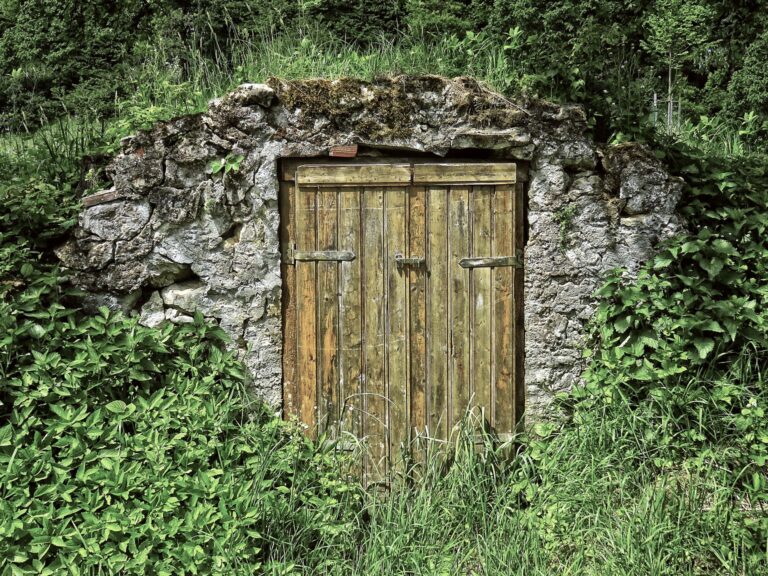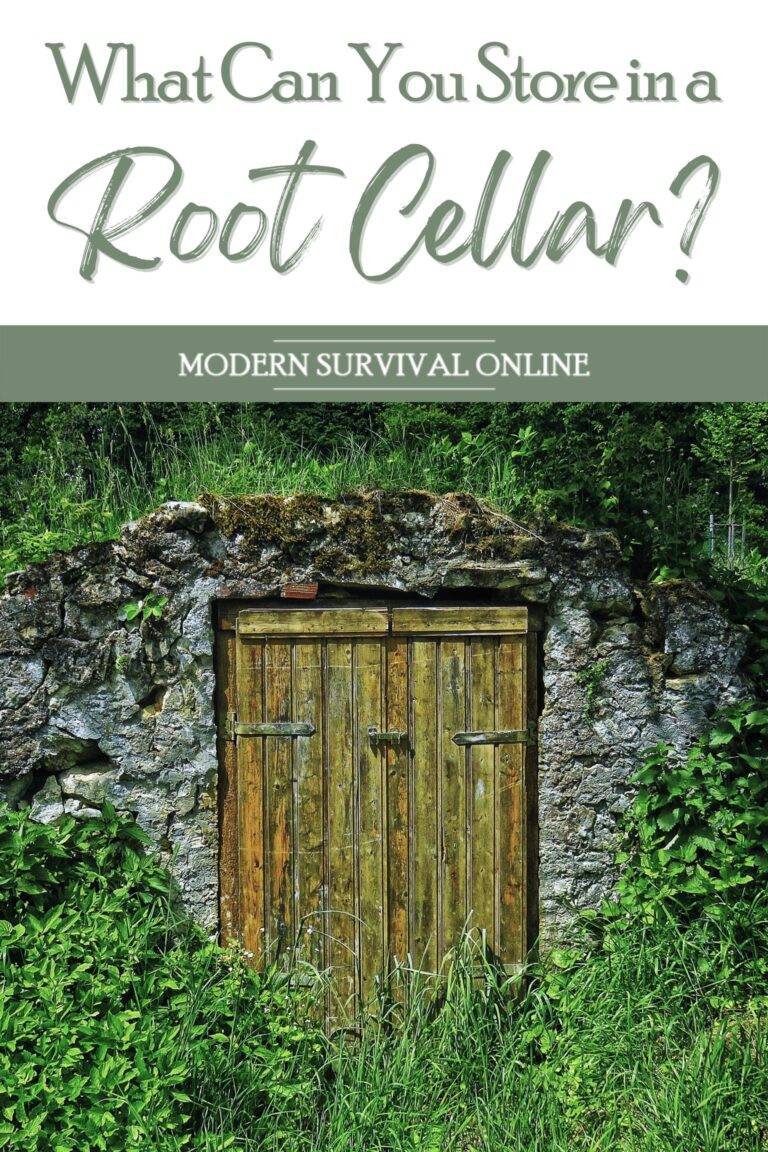Root cellars used to be the residential standard for storing food long term prior to the advent of modern refrigeration technology.

With increasing uncertainty about the status of modern society and especially utilities, root cellars are making a comeback in prepping circles. But what all can you store in a root cellar?
Root cellars are capable of storing many kinds of food: fresh produce, meats, dairy products, herbs, nuts, eggs, and more. They also work well for long-term temperature-controlled storage of other goods such as batteries.
It turns out that your great, great grandparents actually did know a thing or two about taking care of business without dependence on the rest of society.
A root cellar might be just the thing for taking your self-reliance plan to the next level. Keep reading to learn more about how root cellars work and what you can store in them for the best results.
How Does a Root Cellar Work, Exactly?
Root cellars work by providing a controlled and consistently cool, dry environment for the long-term storage of food and other goods.
By keeping out light and moisture and keeping temperatures low or at least lower than normal ambient, shelf lives can be greatly extended and spoilage minimized. But using a root cellar properly and tails some know-how, as with most things.
Chances are you already know that hot air rises while cool air sinks, and that means that the area in the root cellar closer to the floor will be even cooler compared to the area near the ceiling. Knowing this, it is possible to plan out your storage for best results.
Fruits, vegetables, and items with a higher fat content should be kept closer to the floor where the root cellar is coolest since these items are vulnerable to fermentation and going rancid respectively.
Conversely, items that are less vulnerable to spoilage can be stored higher up where it is a little bit warmer.
Storage conditions have more to consider, namely whether you will store produce in baskets or bins, by hanging, or by some other method.
Ensuring adequate air circulation, minimizing the presence of light in any form inside the cellar and other factors should also be considered.
But consider this first and foremost: root cellars have worked for ages, and can continue to work today either as a supplement, backup, or replacement to modern refrigeration if you want to decrease your dependency on electricity. Keep reading to learn the ins and outs of keeping various items in a root cellar.
Fresh Produce is Perfect for Root Cellar Storage
One of the best and probably the most iconic candidates for storage in a root cellar is fresh produce, and with good reason.
Both fruits and vegetables tend to do quite well when kept in the cool, dark confines, though each type has its own storage requirements that you’ll need to be aware of.
Vegetables, and root vegetables in particular, are some of the most stellar examples for root cellar storage- it’s in the name!- and can last for many months without spoilage.
Potatoes, beets, carrots, onions, squash, melons, and more all do wonderfully and you can expect at least 6 months from most of them.
Considering that most vegetables have a significantly lower sugar content than many fruits you won’t have to worry about spoilage or fermentation nearly as much, particularly when temperatures rise just a little bit.
But speaking of fruits, you can keep many fruits easily in your root cellar, gaining several months of shelf life and, for certain types, maybe even as long as a year.
Apples, pears, grapes, tomatoes, oranges, and grapefruit are all examples that will do well during root cellar storage.
However, compared to most vegetables you’ll have to exercise a little more care since many fruits emit various gasses during ripening that can accelerate the ripening of other, nearby fruits or even spoil them.
Still, this is a relatively small concern and compared to keeping them on your counter you’ll be happy to know that most vegetables and many fruits will be near permanent residents of your root cellar.
All Kinds of Meats Keep Well
Believe it or not, it is possible to store fresh cuts of meat in a root cellar, and though they are unlikely to last as long as fruits and vegetables, a meaningful extension of storage life is achievable.
Keeping meats low and near the floor, especially when ambient temperatures are already cool or cold, is important for best results.
Another good option is storing already preserved meat in your root cellar since the stable temperature and good ventilation will further help to prevent spoilage.
Beef, pork, poultry, and even fish may be safely kept in a root cellar in the right climate.
Even Dairy Products Can Last Longer
In what is sure to be a major surprise to some readers, even your dairy products can be stored, for a time, and a root cellar.
Cheeses are the most obvious product that is suitable for long-term root cellar storage, and hard cheeses in particular.
Soft cheeses, though not ideal, will still keep longer in a root cellar than they would in uncontrolled storage.
But it isn’t just cheeses that you can keep in your root cellar. Fresh milk may keep up to 2 weeks in a cool root cellar, with fresh yogurt lasting a little bit longer.
In general, the colder that your root cellar is the better it will do for dairy storage, but so long as you don’t have a root cellar in an environment that is already sweltering you can generally count on it for a significant increase in the shelf lives of your dairy products.
Herbs, Nuts, and More
Herbs and nuts are another perfect inclusion for root cellar storage. Fresh herbs generally do well, particularly when hanged from the ceiling to dry or stored in airtight containers or zipper bags.
For herbs that are intended to be used fresh, you should get at least a couple of weeks of storage out of them, whereas properly dried herbs can last for years in a root cellar.
Nuts do wonderfully in a root cellar also. Typically kept in baskets, barrels, or other containers, as long as the nuts are completely dry and ripe you won’t have any problems.
One thing to keep in mind when storing both nuts and herbs is that the moisture they release can raise the overall humidity level in the root cellar if it is not well ventilated.
In the case of nuts if they are put away moist it might lead to a domino effect of rot that can wipe out an entire container.
Baked Goods are Good to Go
Another surprise, most fresh baked goods will keep pretty well in a root cellar. Fresh breads and other such items tend to go bad in warm conditions, so the cool darkness of a root cellar will give you several extra days or perhaps as long as a week over typical storage.
Baked goods that are already designed for the long haul like hardtack, crackers, hard biscuits, and more will keep even better in a root cellar than they will in your pantry or other dry storage locations.
Non-Food Items, Too
A root cellar is optimal for the long-term storage of food, but you can store more than just food in your root cellar.
Any item that would benefit from a cool, ventilated, and temperature-stable storage will do well in a root cellar. This could be things like batteries or even ammunition, and many other things besides.
The only rules are that you should be cautious that whatever you are storing is completely stable and will not emit any gasses or other materials that could harm or taint what food you have stored in the root cellar with it.
Alternatively, it is entirely viable to make a root cellar that is just a rudimentary but temperature-controlled storage room for equipment and supplies.


Like what you read?
Then you're gonna love my free PDF, 20 common survival items, 20 uncommon survival uses for each. That's 400 total uses for these dirt-cheap little items!
We will not spam you.